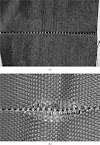Various Zones in Circular Knitting Machine
 |
| Circular Knitting Machine Parts |
In process of making circular knit fabric, there are various zones in knitting machine as per following:
1) Creel
Yarn supply packages are mounted on the creel. Yarn packages may in cheese or cone structure. Their are two types of creels –
A)Top Creel (Overhead)
B)Side Creel
Out of this creel, side creel is most popularly used in the knitting industry. The reasons for the use of side creel are – It is easy for loading and unloading of the packages, more space availability for supply packages, bigger packages can be mount on side creel, more the number of supply packages more will be the number of feeders, thus production will be more.
2) Transport Tube
Transport tube is used to carry the yarn from supply packages to the yarn feeding device. It is mainly of plastic or nylon material. It gives yarn a particular path so that no entanglements will occur.
3) Yarn Feeding Device
Yarn feeding device provides the feeder with yarn with constant tension. This will reduce the yarn breakages during production. Their are various yarn feeding devices are used as per requirement for the yarn.
A)Conical Gear Type
B)Drum and Belt
C)Positive Feeder with Reverse Yarn System
II. Knitting Zone
1) Needle
In machine knitting a series of needles is used to form the stitches. They perform different
functions depending on the knitting process and the type of needle. Different types of needles used in knitting machine are:
1) Latch Needle
2) Compound Needle
3) Spring Bearded Needle
Let’s see various parts of needle and it’s functions:
1) Hook –
A knitting needle has a hook at one end to hold the yarn passed to the knitting zone. It performs opening and closing function for releasing and catching loop respectively.
2) Shaft –
A stem (or shaft) to carry the knitted loop during the initial stage of the loop formation process. Thus old loops can rest on shaft.
3) Butt –
A butt is at the other end of the needle. The butt is used either to position the needle on a needle bar or to move the needle during the stitch formation process through the cam.
4) Latch –
Before the new yarn loop can be drawn through the knitted loop, the previous loop must be closed for the knitted loop to slide over the closed hook. Thus all needles must have a means of closing and opening the needle hook – there are three ways in which this may be achieved:
1. applying an external force, as in the bearded needle;
2. using movement of knitted loop relative to knitting needle, as in the latch needle;
3. using an additional closing element, as in the compound needle
2) Cylinder
A cylinder is a round metal bed with grooves / trunks / cuts at its outer edges where the needles are inserted. In terms of grooves, the needles move straight up and down with their butt to connect to the cam track. The needles mounted in cylinder is called as cylinder needles. The number of grooves per inch e.g., the number of needles per inch determines the machine gauge. The machines are built as low as 4 NPI and up to 32 NPI. Depending on the machine gauge, the fineness of the yarn to be knitted can be varied.
3) Dial and Sinker Plate
Sinker is a part of single jersey machines. Sinker is a divider blade which moves or pushes the yarn alternately between the needles. It acts as a loop-forming device in conjunction with the needle. Sinkers are generally placed at 90° to the needle bed. Also it holds the older loops at the bottom portion of the needle. Thus prevent the old loops from being lifted with needles as they rise to release them from their hooks.
Dial is an top metal needle bed used for the double jersey machines. In dial their are grooves same as cylinder, needles are inserted into this grooves and allowed to go in and out through their dial cam. Needles mounted in dial is known as dial needles.
III. Take Down Zone
The takedown mechanism pulls the knitted fabric from the needles and winds it onto the fabric roll. The take down mechanism consists of grooved rollers through which the fabric is gripped and pulled down. Roll winding mechanism provides the fabric storage where a flat, double ply fabric is wound on a rotating square bar. The takedown and winding mechanism can be operated by the main drive of the machine or by an additional precise current motor.











0 Comments
If you have any doubts, please don't hesitate to ask